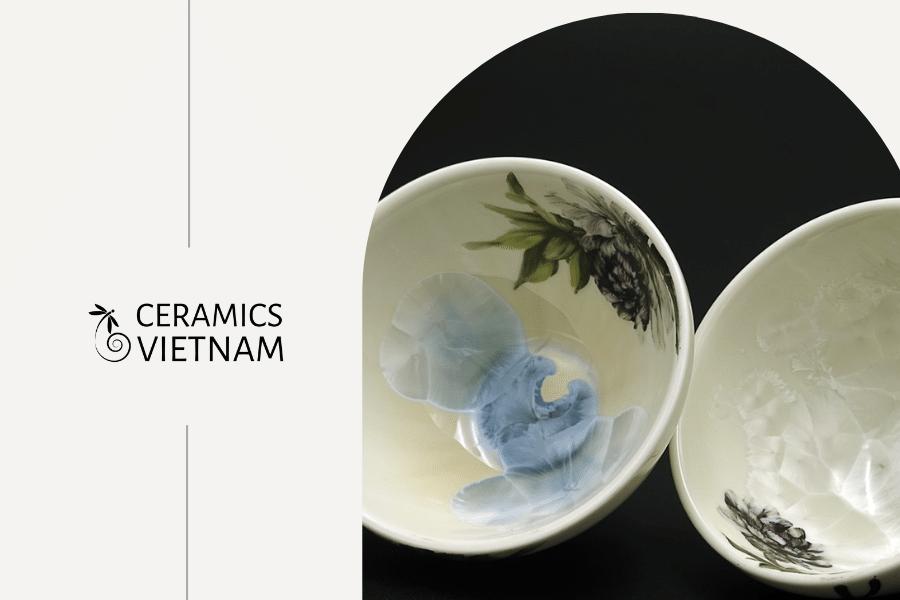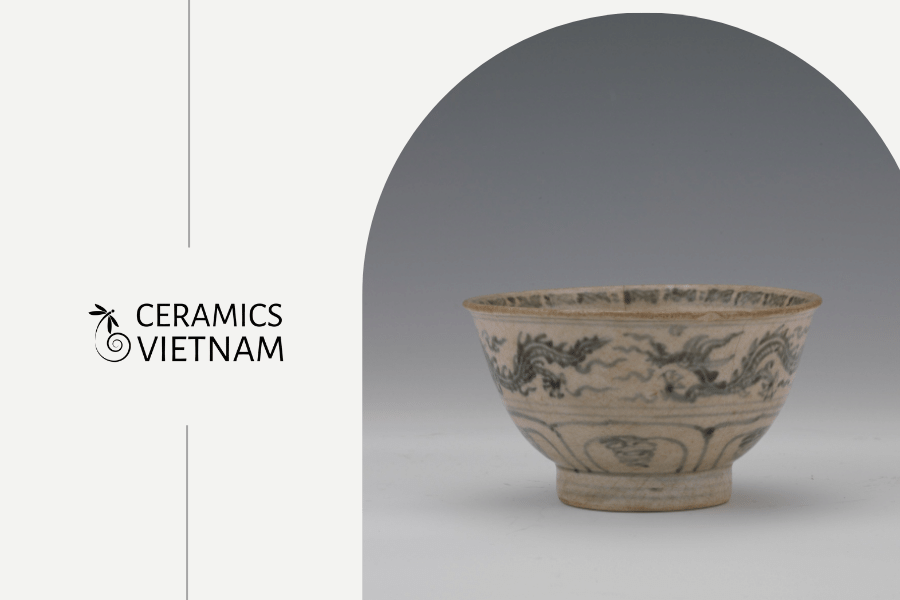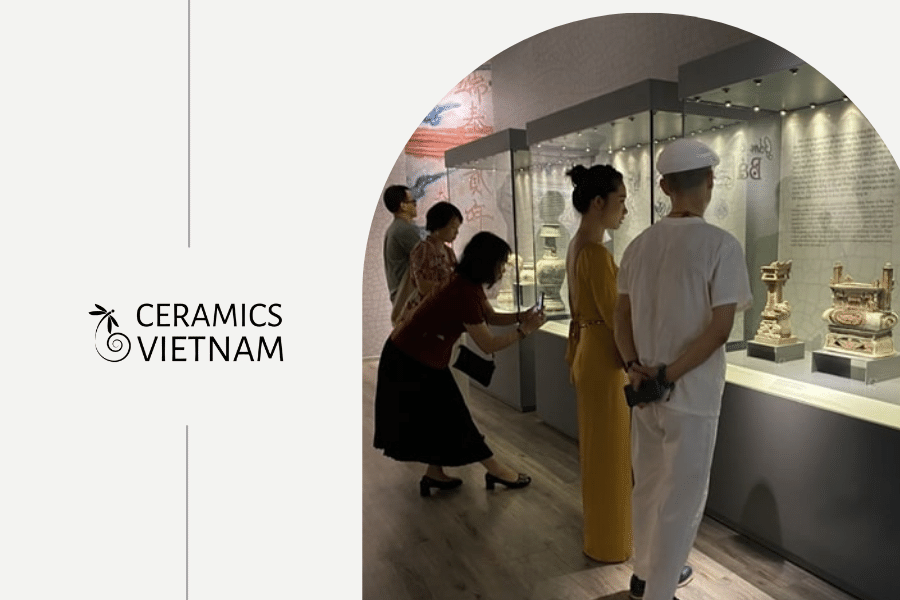In celebration of International Museum Day on May 18, an exhibition centered around the captivating theme of “Bat Trang Ancient Pottery” is set to showcase a remarkable collection of ceramic artifacts dating from the 14th to the 20th century
Bat Trang Ceramics – Vietnam’s Cultural Heritage

Vietnamese ceramics Bat Trang ancient ceramics on show in Hanoi
The enduring legacy of Bat Trang ceramics is deeply intertwined with Vietnam’s cultural heritage. Its artistry and craftsmanship have been nurtured over centuries, leaving an indelible mark on the nation’s history. As a revered art form, Bat Trang ceramics serves as a tangible link to the past, preserving the essence of Vietnam’s rich cultural traditions.
Rooted in history and tradition, the origins of Bat Trang ceramics can be traced back through the annals of time. Dating back centuries, this art form has witnessed the rise and fall of dynasties, the passage of time, and the evolution of society. As a result, it has become a repository of the nation’s cultural richness, encapsulating the essence of Vietnam’s artistic heritage.
The evolution of Bat Trang ceramics has been a journey of creativity and innovation. Passed down from one generation to the next, the art form has embraced change while holding true to its distinctive style. Artisans have honed their skills, refining techniques, and infusing their own creativity into every masterpiece. Each piece of Bat Trang ceramics tells a story of passion, dedication, and artistic prowess, reflecting the ingenuity of its creators.
In Vietnamese society, Bat Trang ceramics has transcended mere utilitarian purposes and attained multifaceted significance. Historically, it adorned the daily lives of the people, adding beauty and functionality to their households. Yet, it goes beyond practicality and extends into sacred ceremonial contexts. In religious practices and rituals, Bat Trang ceramics plays a vital role, signifying reverence and spirituality.
The cultural impact of Bat Trang ceramics is evident in various aspects of Vietnamese life. Its influence extends to culinary traditions, where its finely crafted bowls and dishes grace tables during important family gatherings and festivals. Additionally, its intricate designs and patterns inspire other forms of artistic expression, influencing architecture, textiles, and various decorative arts.
The exhibition of Bat Trang ceramics serves not only as a celebration of artistic brilliance but also as a reminder of the importance of preserving Vietnam’s cultural heritage. Through showcasing the exquisite pieces of this traditional art form, the exhibition fosters an appreciation for the customs and traditions that have shaped Vietnamese identity over the centuries.
As visitors explore the exhibition, they are transported through time, connecting with the artisans of the past and their dedication to preserving their craft. It reinforces the significance of safeguarding cultural legacies, ensuring that the artistry of Bat Trang ceramics continues to inspire and enrich the lives of future generations.
In essence, Bat Trang ceramics stands as a testament to the cultural wealth of Vietnam, encapsulating the spirit and creativity of its people. As the exhibition continues to captivate hearts and minds, it reminds us that preserving and cherishing cultural heritage is a shared responsibility, an ode to the brilliance of the past and the promise of the future.
Unveiling Vietnam’s Treasures: The Captivating Journey of Bat Trang Ancient Pottery

Vietnamese ceramics Bat Trang ancient ceramics on show in Hanoi
The National Museum of History’s long-awaited exhibition, which opened on May 18, has enthralled visitors with its captivating theme: “Bat Trang Ancient Pottery.” The exhibition is thoughtfully divided into four distinct themes, each offering a unique glimpse into the rich legacy of Bat Trang pottery.
The first theme, “History of Formation,” takes visitors on a journey through time, exploring the origins and evolution of Bat Trang pottery. It delves into the historical context that shaped the village’s emergence as a hub of exquisite ceramics.
Moving on, the second theme, “14th Century Bat Trang Pottery,” showcases a collection of remarkable artifacts from the early days of Bat Trang’s ceramic craftsmanship. Visitors can marvel at the exquisite pieces that reflect the artistic sensibilities of that era.
The third theme, “15th to 18th Century Bat Trang Pottery,” offers a deeper exploration of the village’s growth and development during this period. This era witnessed a flourishing trade in ceramics, and the exhibition displays some of the finest examples of pottery produced during this golden age.
Finally, the fourth theme, “19th to 20th Century Bat Trang Pottery,” brings visitors into the modern era of Bat Trang ceramics. Here, they can witness the innovation and evolution of the art form, as well as its cultural significance during this transformative time.
The museum’s curators have worked diligently to assemble an extensive and valuable collection, reflecting the immense research and dedication invested in preserving Bat Trang pottery’s heritage. This exhibition not only celebrates the artistry and craftsmanship of the past but also underscores the importance of preserving Vietnam’s cultural history for future generations.
As visitors stroll through the exhibition, they are immersed in the world of glazed ceramics, each piece carrying a unique tale of history and culture. The intricate designs and aesthetic brilliance of the pottery serve as a testament to the artistic achievements of the region.
With this grand display of Bat Trang pottery, the National Museum of History aims to ignite a renewed appreciation for the cultural treasures of Vietnam. The exhibition serves as a reminder of the role ceramics have played in shaping the nation’s identity and the need to safeguard this heritage for posterity.
From historians and art enthusiasts to the general public, all are invited to partake in this mesmerizing journey through time and explore the enduring legacy of “Bat Trang Ancient Pottery.”
Bat Trang Pottery: A Living Legacy of Vietnam’s Ceramic Heritage

Vietnamese ceramics Bat Trang ancient ceramics on show in Hanoi
The museum’s representative expressed how Bat Trang pottery has been the focal point of the museum’s research and collection efforts for numerous years, culminating in a valuable and extensive assortment.
This exhibition aims to promote a rich collection of glazed ceramics, brimming with historical, cultural, and aesthetic significance, while also raising public awareness about the critical importance of preserving Vietnam’s cultural heritage.
Experts highlighted the enduring history of Vietnamese ceramics, which has played a significant role in the lives of people since prehistoric times. Starting from the 10th century, ceramics production experienced robust growth, contributing significantly to the nation’s economic and cultural development.
During the 15th to 17th centuries, ceramics became vital export commodities, paving the way for a remarkable advancement in both quantity and quality of production. Nevertheless, as time passed, many ceramics manufacturing centers gradually declined from the 18th century onwards.
Remarkably, Bat Trang, the renowned ceramics village in Hanoi’s suburban Gia Lam district, which traces its roots back to the 14th century, not only survived but thrived, transforming itself into a living “museum” of Vietnamese ceramics.
Despite enduring various challenges, Bat Trang’s ceramic products are still highly esteemed for their exceptional quality, boasting a wide array of designs, models, and types.
Today, approximately 200 enterprises and 1,000 households are engaged in the production and trade of ceramic wares in Bat Trang, with their products finding markets in several countries, including Japan, the Republic of Korea, Thailand, Russia, Italy, and France














Leave a reply